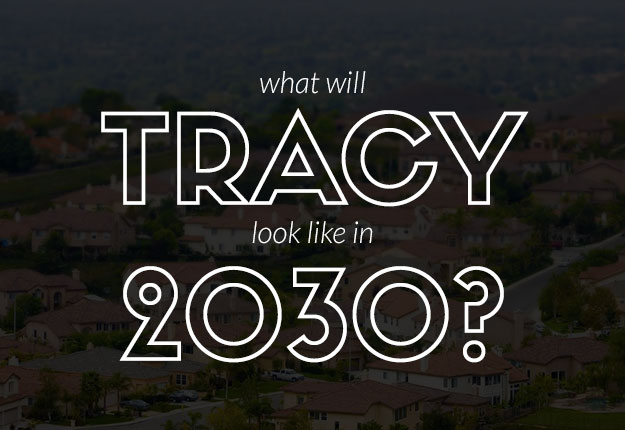
Between 2000 and 2010, Tracy’s population shot up nearly 50%, from 56,929 to 82,922. Longtime residents will tell you the town has changed: Tracy has been flooded by Bay Area residents looking for more affordable housing, businesses looking for new transportation hubs, and new infrastructure that is struggling to keep up with the astronomical growth.
But what many Tracy residents don’t realize is that this is still just the beginning. Depending on who you ask, by 2030 Tracy could be California’s newest tech hub, home to the biggest theme park in California, or something else entirely.
Let’s take a look at some of the biggest forces shaping Tracy’s future and try to answer the question: what will Tracy look like in 2030?
Five Factors that Could Transform the City of Tracy by 2030

1. More housing
According to The Tracy Press, home building is back. In 2015, the city issued permits for over 300 apartments and over 160 single family homes, which is more than any previous year since the recession. Another development, called Tracy Hills, which has been in the works since 1993, is finally kicking up dirt once more. The housing development calls for an initial phase of 5,499 homes to be built off of I-580.
“‘This is such a large project,” said Pete Mitracos, Vice Chairman of the Tracy City Council. “If we build it out, it’s almost twice as large as the small-town Tracy that I grew up in.”
Any way you slice it, by 2030 Tracy will be home to a lot more people. You can expect the city to collect more tax revenue for public services like schools and the police department, but increased road congestion is also a real possibility.

2. More higher education
Tracy could become a college town by 2030. Notre Dame de Namur University opened up a Tracy campus in Fall 2015, offering MBA and BS degrees to Tracy residents. As more and more people relocate to Tracy, we expect to see more demand for higher education institutions in town. Who knows, Tracy in 2030 could be the home to its very own California State University.
The President of Notre Dame de Namur (NDNU), Judith Greig, stated that she is “looking forward to continuing to build our association with the Tracy community and expanding our offerings in the future.” Many officials are hoping that the success of the NDNU Tracy campus will show other universities how beneficial a university culture is to the community – and just how many students are willing to attend.
“I think we’ve been able to demonstrate to NDNU how much having a university here means to this community,” said the chair of the Tracy Consortium for Higher Education, Roger Birdsall.
It’s too early to say that another institution will be open, or even announced, by 2030 but the ramifications could be enormous. If Tracy does get another college you can expect high job growth in a variety of industries, more money spent locally, and higher demand for affordable goods and services.

3. More public transit
Tracy has long been hassled for having one of the worst commute times in the country. However, this will get better by 2030, and several projects are already in the works.
First off, BART will finally complete it’s extension to Livermore, which is set to finish in 2026. This means a shorter commute for Tracy residents who want to take BART to the city or elsewhere for work.
The Altamont Commuter Express (ACE) train also has some improvements in the works. By 2018, the train will extend to downtown Modesto, and to downtown Merced by 2022. ACE also plans to increase the number of trains so that there will be more frequent, faster, and safer commute options. The current 3 round trips will be increased to 6 round trips in 2018, and 10 round trips by 2022. Manteca, Modesto, Turlock, and Merced could see ACE train service, as could downtown Tracy.
It should go without saying that better transportation options should have a significant impact on Tracy’s road congestion, housing prices, and quality of life.
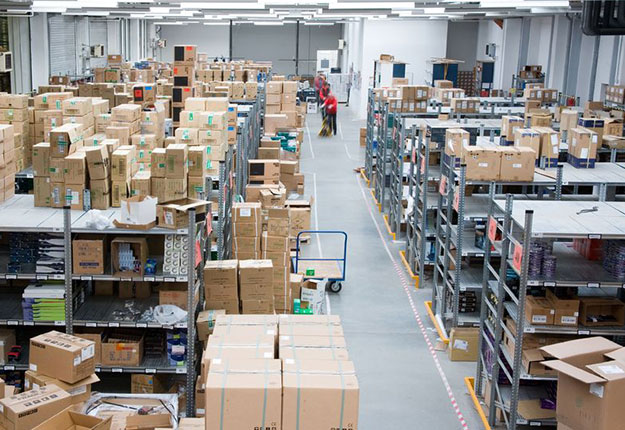
4. More jobs
When the Amazon fulfillment center opened its doors in Tracy in 2013, it created over 1,000 new job opportunities. The following year, they added 200 more jobs, and another 800 more in 2015. As the world’s largest online retailer, the Tracy Amazon warehouse is surely going to continue providing more and more jobs through 2030.
But Amazon isn’t the only big player in Tracy. Medline and FedEx Industries plan to become part of the Prologis International Park of Commerce, a 1700-acre facility completed in 2015. Medline, a major medical supply manufacturer, is opening a 1 million square foot facility in early 2016, providing hundreds of jobs. FedEx is planning to open a 467,000 square foot facility in August of 2016, and the Mayor of Tracy, Mike Maciel, sad “this is just the beginning.”
With these major players entering the Tracy scene, we know that Tracy in 2030 has the potential to be the HQ for many of today’s big companies. More jobs in Tracy proper also means less time wasted on long commutes and more time spent enjoying outings with family and friends (what a novel concept!). Residents will also spend more of their money locally, rather than having to drive to the Bay Area for shopping and recreation. As a result, we expect to see an overall increase in job satisfaction and quality of life for Tracy residents.

5. More fun
Been feeling like there’s not enough to do in Tracy? Well, Tracy in 2030 could be the home to the Spirit of California theme park. This park, which is still in the works, is set to be completed by 2024 – and it could topple Disneyland for the title of biggest theme park in the West. The current proposal has plans for a casino, rides, wine tasting center, sports complex, golf course, equestrian center, boat marina, and more.
The Spirit of California could put Tracy on the map as a tourist destination for folks all over the world. This would create new jobs, new infrastructure, and a revitalized Tracy. However, there are many who doubt the feasibility of such a large-scale project. Many believe that Spirit of California is a mere pipe dream, and it has come under fire for seeking money from shareholders. The head of the Building and Industry Association of the Greater Valley, John Beckman, said “my only trepidation is like many of those big, grand ideas – they go a little ways and then don’t go anywhere. If the guy was able to actually build it, it’d be incredible.”
Other Big Changes to Tracy
Based on historical demographic and population data, we expect big things from Tracy in the future. These projections could be affected by several factors, including all of the ones listed above.
Median home value will grow by 2030
Median home value in Tracy is expected to grow by over 20% between 2015 and 2030.
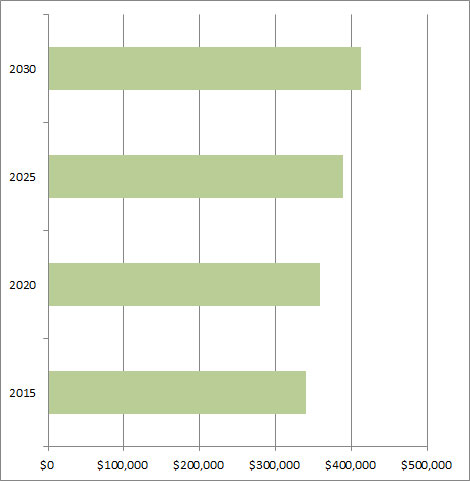
| Year | Value |
|---|---|
| 2015 | $339,396 |
| 2020 | $357,936 |
| 2025 | $389,224 |
| 2030 | $412,566 |
Tracy will be more diverse by 2030
Estimates show a large increase in residents who identify as Hispanic, mixed race, Asian, and other races by 2030.

| 2015 | 2030 | |
|---|---|---|
| Total | 85,182 | 94,140 |
| White | 51.4% | 47.6% |
| Black | 6.9% | 5.8% |
| Native American | .9% | .7% |
| Asian | 14.6% | 16.1% |
| Pacific Islander | .9% | 1% |
| Other | 17.0% | 20.1% |
| Mixed Race | 8.2% | 9.7% |
| Hispanic | 39.4% | 48.1% |
Population age will shift by 2030
By 2030, Tracy will be home to more people in the 25-34 and 55-74 age groups, but fewer in the 0-24 and 35-54 age groups. These predictions could be drastically affected by the Spirit of California development, as well as changes to educational institutions in Tracy.
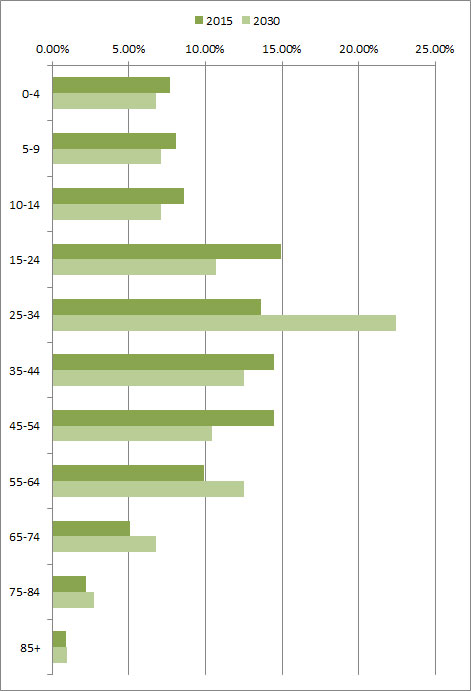
| 2015 | 2030 | |
|---|---|---|
| 0-4 | 7.7% | 6.8% |
| 5-9 | 8.1% | 7.1% |
| 10-14 | 8.6% | 7.1% |
| 15-24 | 14.9% | 10.7% |
| 25-34 | 13.6% | 22.4% |
| 35-44 | 14.5% | 12.5% |
| 45-54 | 14.5% | 10.4% |
| 55-64 | 9.9% | 12.5% |
| 65-74 | 5.1% | 6.8% |
| 75-84 | 2.2% | 2.7% |
| 85+ | 0.9% | 1% |
Household income will grow by 2030
Thanks to demographic shifts and new employment opportunities, Tracy’s average household income is expected to grow by over 30% between 2015 and 2030
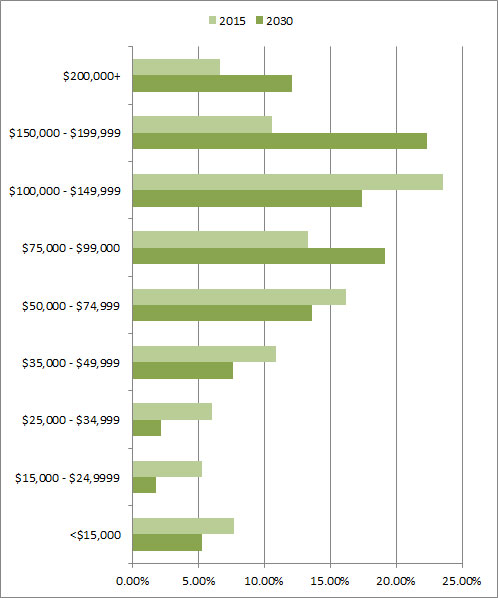
| 2015 | 2030 | |
|---|---|---|
| <$15,000 | 7.7% | 5.3% |
| $15,000 – $24,9999 | 5.3% | 1.8% |
| $25,000 – $34,999 | 6.0% | 2.2% |
| $35,000 – $49,999 | 10.9% | 7.6% |
| $50,000 – $74,999 | 16.2% | 13.6% |
| $75,000 – $99,000 | 13.3% | 19.1% |
| $100,000 – $149,999 | 23.5% | 17.4% |
| $150,000 – $199,999 | 10.6% | 22.3% |
| $200,000+ | 6.6% | 12.1% |
What Do You Think Tracy Will Look Like in 2030?
Let us know in the comments, on Facebook, or on Twitter.
Additional sources:
http://www.ci.tracy.ca.us/documents/Demographic_Overview.pdf
http://www.bestplaces.net/economy/city/california/tracy
http://www.bestplaces.net/people/city/california/tracy





